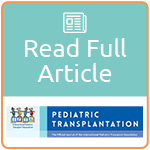Abstract
Background
 Learning Health Networks (LHN) have evolved within medicine over the past two decades, but their integration into transplantation has been more recent.
Learning Health Networks (LHN) have evolved within medicine over the past two decades, but their integration into transplantation has been more recent.
Objectives and Methods
In this paper, we describe three LHNs in end-stage organ disease/transplantation, their common and unique features, and how their “actor-oriented” architecture allowed for rapid adaptation to meet the needs of their patients and practitioners during the recent COVID-19 pandemic.
Result
The structure and focus of the Improving Renal Outcomes Collaborative (IROC), Starzl Network for Excellence in Pediatric Transplantation (SNEPT), and the Advanced Cardiac Therapies Improving Outcomes Network (ACTION) are reviewed. We discuss the critical role of patient and family engagement, focusing on collaboration with Transplant Families. Finally, we review challenges common to the LHN concept and potential common areas of alignment to achieve the goal of more rapid and sustained progress to improve health in pediatric transplantation.
Conclusion
LHN in transplantation are essential to accelerate knowledge dissemination and improve outcomes.
This ACTION study was published by Wiley in Pediatric Transplantation on October 24, 2024. Congratulations to the authors:
- Roshan P. George
- Amy G. Feldman
- Melissa McQueen
- Cassandra Krise-Confair
- Lauren Smyth
- Angela Lorts
- David M. Peng
- George V. Mazariegos
- David K. Hooper
CITATION
George, R., Feldman, A., McQueen, M., Krise-Confair, C., Smyth, L., Lorts, A., Peng, D., Mazariegos, G. and Hooper, D. (2024), Pediatric Learning Health Networks in Solid Organ Transplantation—Engaging all Stakeholders to Achieve Health for Children Who Require Transplantation. Pediatric Transplantation, 28: e14862. https://doi.org/10.1111/petr.14862
